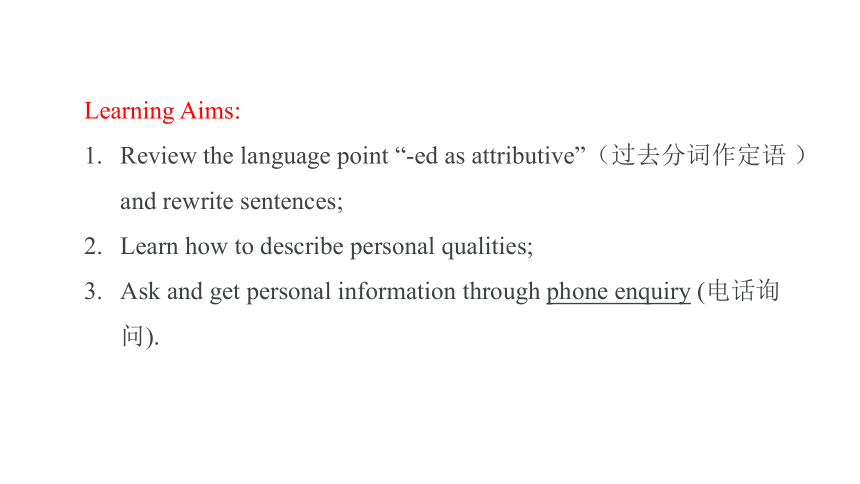外研版(2019)必修 第三册Unit 2 Making a difference Using language课件(共19张PPT)
文档属性
| 名称 | 外研版(2019)必修 第三册Unit 2 Making a difference Using language课件(共19张PPT) |  | |
| 格式 | pptx | ||
| 文件大小 | 1.1MB | ||
| 资源类型 | 教案 | ||
| 版本资源 | 外研版(2019) | ||
| 科目 | 英语 | ||
| 更新时间 | 2023-05-29 19:05:00 | ||
图片预览







文档简介
(共19张PPT)
Using language—Verb -ed as
attributive
Learning Aims:
Review the language point “-ed as attributive”(过去分词作定语 )and rewrite sentences;
Learn how to describe personal qualities;
Ask and get personal information through phone enquiry (电话询问).
语法感悟
感知以下句子,并完成方框下面的练习
1....Ryan had trouble believing the words spoken by his teacher...
2.What they needed was a well dug near their homes.
3.In Uganda,Ryan at last saw the finished well with his own eyes.
4.There are fallen leaves here and there.
5.Is there anything unfinished
1.以上句子中使用了过去分词(短语)作_____。句1和句2中作定语的是______________,句3和句4中作定语的是________________。
2.及物动词的过去分词(短语)作定语时,如句1,2,3,5,既表示______又表示_____。不及物动词的过去分词(短语)作定语时,如句4,只表示_____。
定语
过去分词短语
单个的过去分词
被动
完成
完成
3.单个的过去分词作定语,常常放在被修饰名词的______;过去分词短语作定语,常常放在被修饰名词的______。但句5中的unfinished放在被修饰词之后,因为被修饰词anything是__________。
4.过去分词(短语)作定语相当于一个_________,如句1中,spoken by his teacher=which were spoken by his teacher。及物动词的过去分词扩展成定语从句时,一定是______语态。
前面
后面
不定代词
定语从句
被动
一、过去分词作定语时的位置
一般情况下,单个的过去分词作前置定语,即放在所修饰词的前面;过去分词短语作定语时往往作后置定语,即放在所修饰词之后,相当于一个定语从句。
The injured workers are now being taken good care of in the hospital.
受伤的工人们现在正在医院受到良好的照顾。
To return to the problem of water pollution,I’d like you to look at a study conducted in Australia in 2012.
=To return to the problem of water pollution,I’d like you to look at a study which was conducted in Australia in 2012.
回到水污染的问题上,我想让你看一下2012年在澳大利亚做过的一项研究。
温馨提示
(1)有些过去分词可以表示特定含义,单独作定语时要放在所修饰的名词之后,如left(剩余的),given(所给的),concerned(有关的)等。
There were a couple of seats left at the back.
后面还剩几个座位。
(2)如果被修饰的词是指示代词those或something,everything,anything,nothing,nobody等不定代词,单个的过去分词作定语要放在这些词的后面。
He is one of those invited.
他是那些被邀请的人之一。
(3)有些过去分词作定语时,前置和后置的意义不同。
The authorities concerned are to blame.
有关当局应受到指责。
She looked at me with a concerned look.
她关切地望着我。
二、过去分词作定语时的意义
1.及物动词的过去分词作定语时,在语态上表示被动;在时间上,常表示动作已经发生或完成,有时只表示被动。
He is a teacher respected by all the students.
他是一位受所有学生尊敬的老师。(只表示被动)
The plan put forward at the meeting will be carried out soon.
会上提出的这项计划将很快被执行。(表示完成和被动)
2.不及物动词的过去分词作定语时,不表示被动意义,只强调动作完成。
The risen sun is shining brightly in the morning.
早晨,升起的太阳明亮地照耀着。
When I woke up the next morning,I found the ground was covered with fallen leaves.
当我第二天早上醒来时,发现地面被落叶覆盖了。
三、不同非谓语动词形式作定语的区别
语法 形式 意义
动词-ing形式作定语 doing 表示主动动作正在进行;表示经常性的动作或现在(当时)的状态
being done 表示被动动作正在进行
过去分词 作定语 done 表示被动、完成或者被动动作已经完成
不定式 作定语 to do 表示主动动作将要发生
to be done 表示被动动作将要发生
Ryan is a young man admired by a lot of people. The money raised by his foundation supports schools and communities in Africa.
As in the words spoken by Ryan, we need to not only donate money but also get new ideas. I think the needed support includes new technology for recycling water and education on how to use and save water(节约用水).
take up an extended mission: 承担一项长期使命;the United Nations Children's Fund: 联合国儿童基金会;modernisation 现代化; territory 领土,领域,地域,范围
Activity 4: Read the descriptions and underline the words that describe personal qualities.& Activity 5: Put the words into the table.
Liu Tao: sensitive, serious, bookish, independent
Li Mei: shy, generous, honest
Tim: confident, nervous, creative
Anna: easygoing, lazy
Positive 褒义的
Neutral 中性的
Negative 贬义的
independent,
wise,
generous,
honest,
confident,
creative,
easygoing
sensitive,
serious,
bookish,
shy
nervous,
lazy
loyal [ l l] 忠诚的,
intelligent,
determined,
warm-hearted
self-conscious
[ self k n s]
局促不安的,害羞的
strict
short-sighted
近视的; 目光短浅的
selfish, mean吝啬的
slack懈怠的; 不用心的
Using language—Verb -ed as
attributive
Learning Aims:
Review the language point “-ed as attributive”(过去分词作定语 )and rewrite sentences;
Learn how to describe personal qualities;
Ask and get personal information through phone enquiry (电话询问).
语法感悟
感知以下句子,并完成方框下面的练习
1....Ryan had trouble believing the words spoken by his teacher...
2.What they needed was a well dug near their homes.
3.In Uganda,Ryan at last saw the finished well with his own eyes.
4.There are fallen leaves here and there.
5.Is there anything unfinished
1.以上句子中使用了过去分词(短语)作_____。句1和句2中作定语的是______________,句3和句4中作定语的是________________。
2.及物动词的过去分词(短语)作定语时,如句1,2,3,5,既表示______又表示_____。不及物动词的过去分词(短语)作定语时,如句4,只表示_____。
定语
过去分词短语
单个的过去分词
被动
完成
完成
3.单个的过去分词作定语,常常放在被修饰名词的______;过去分词短语作定语,常常放在被修饰名词的______。但句5中的unfinished放在被修饰词之后,因为被修饰词anything是__________。
4.过去分词(短语)作定语相当于一个_________,如句1中,spoken by his teacher=which were spoken by his teacher。及物动词的过去分词扩展成定语从句时,一定是______语态。
前面
后面
不定代词
定语从句
被动
一、过去分词作定语时的位置
一般情况下,单个的过去分词作前置定语,即放在所修饰词的前面;过去分词短语作定语时往往作后置定语,即放在所修饰词之后,相当于一个定语从句。
The injured workers are now being taken good care of in the hospital.
受伤的工人们现在正在医院受到良好的照顾。
To return to the problem of water pollution,I’d like you to look at a study conducted in Australia in 2012.
=To return to the problem of water pollution,I’d like you to look at a study which was conducted in Australia in 2012.
回到水污染的问题上,我想让你看一下2012年在澳大利亚做过的一项研究。
温馨提示
(1)有些过去分词可以表示特定含义,单独作定语时要放在所修饰的名词之后,如left(剩余的),given(所给的),concerned(有关的)等。
There were a couple of seats left at the back.
后面还剩几个座位。
(2)如果被修饰的词是指示代词those或something,everything,anything,nothing,nobody等不定代词,单个的过去分词作定语要放在这些词的后面。
He is one of those invited.
他是那些被邀请的人之一。
(3)有些过去分词作定语时,前置和后置的意义不同。
The authorities concerned are to blame.
有关当局应受到指责。
She looked at me with a concerned look.
她关切地望着我。
二、过去分词作定语时的意义
1.及物动词的过去分词作定语时,在语态上表示被动;在时间上,常表示动作已经发生或完成,有时只表示被动。
He is a teacher respected by all the students.
他是一位受所有学生尊敬的老师。(只表示被动)
The plan put forward at the meeting will be carried out soon.
会上提出的这项计划将很快被执行。(表示完成和被动)
2.不及物动词的过去分词作定语时,不表示被动意义,只强调动作完成。
The risen sun is shining brightly in the morning.
早晨,升起的太阳明亮地照耀着。
When I woke up the next morning,I found the ground was covered with fallen leaves.
当我第二天早上醒来时,发现地面被落叶覆盖了。
三、不同非谓语动词形式作定语的区别
语法 形式 意义
动词-ing形式作定语 doing 表示主动动作正在进行;表示经常性的动作或现在(当时)的状态
being done 表示被动动作正在进行
过去分词 作定语 done 表示被动、完成或者被动动作已经完成
不定式 作定语 to do 表示主动动作将要发生
to be done 表示被动动作将要发生
Ryan is a young man admired by a lot of people. The money raised by his foundation supports schools and communities in Africa.
As in the words spoken by Ryan, we need to not only donate money but also get new ideas. I think the needed support includes new technology for recycling water and education on how to use and save water(节约用水).
take up an extended mission: 承担一项长期使命;the United Nations Children's Fund: 联合国儿童基金会;modernisation 现代化; territory 领土,领域,地域,范围
Activity 4: Read the descriptions and underline the words that describe personal qualities.& Activity 5: Put the words into the table.
Liu Tao: sensitive, serious, bookish, independent
Li Mei: shy, generous, honest
Tim: confident, nervous, creative
Anna: easygoing, lazy
Positive 褒义的
Neutral 中性的
Negative 贬义的
independent,
wise,
generous,
honest,
confident,
creative,
easygoing
sensitive,
serious,
bookish,
shy
nervous,
lazy
loyal [ l l] 忠诚的,
intelligent,
determined,
warm-hearted
self-conscious
[ self k n s]
局促不安的,害羞的
strict
short-sighted
近视的; 目光短浅的
selfish, mean吝啬的
slack懈怠的; 不用心的
